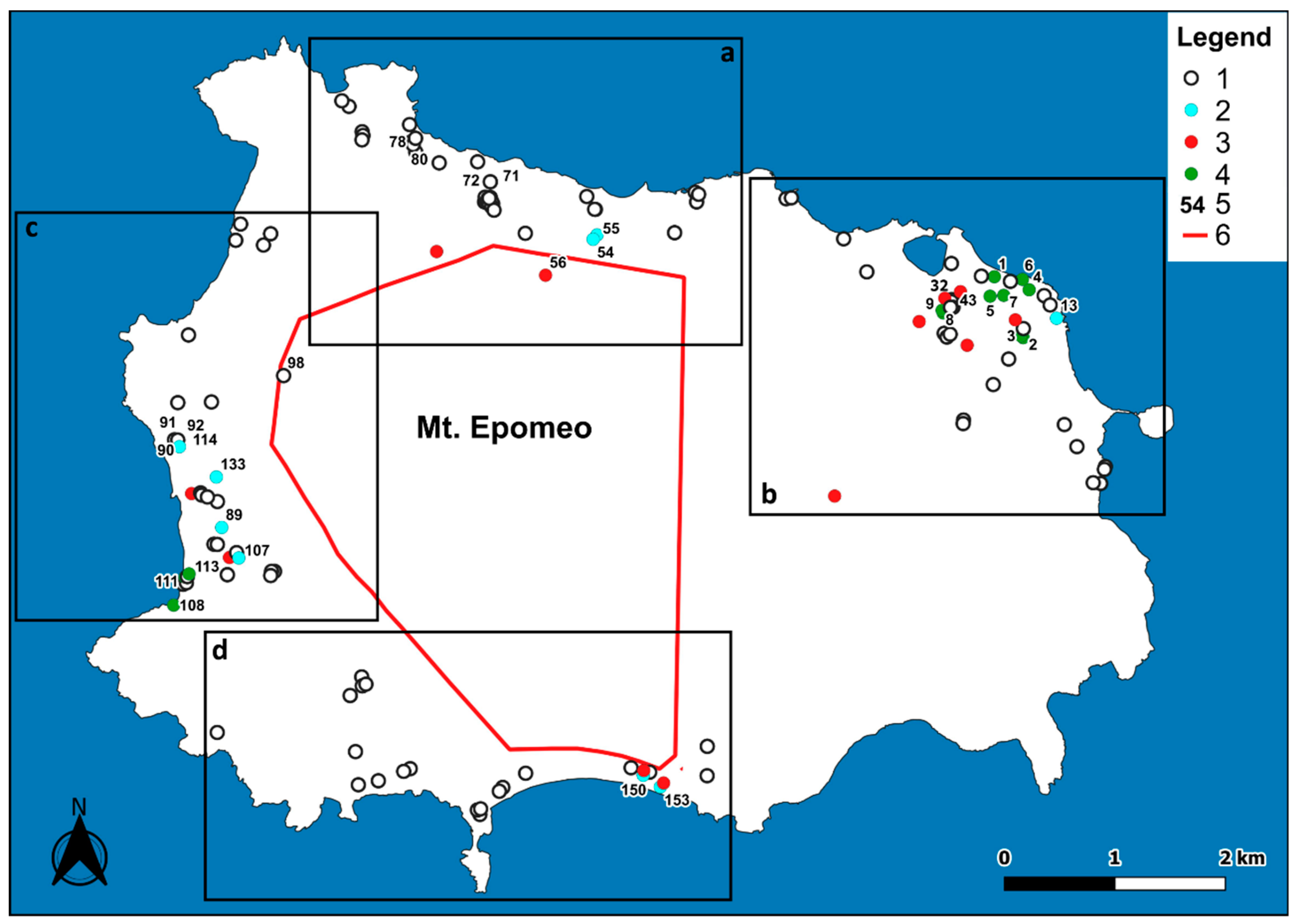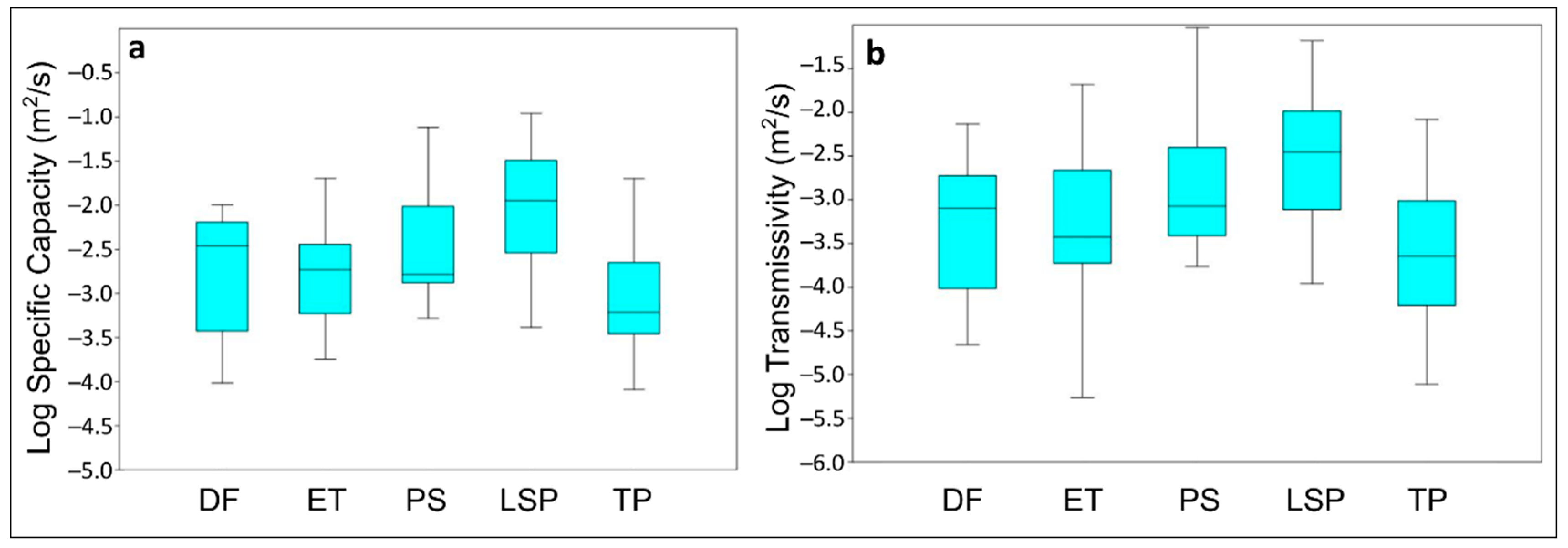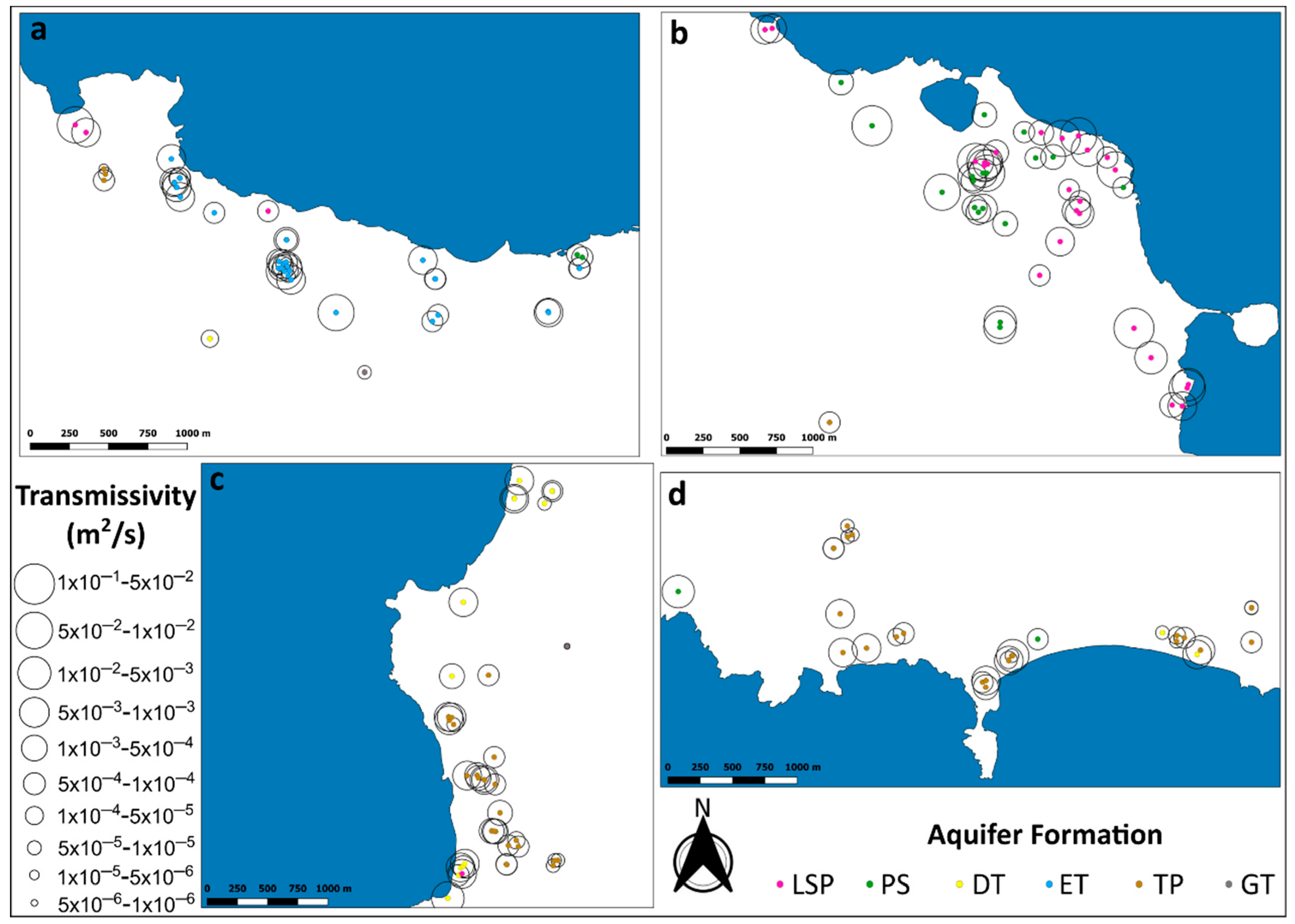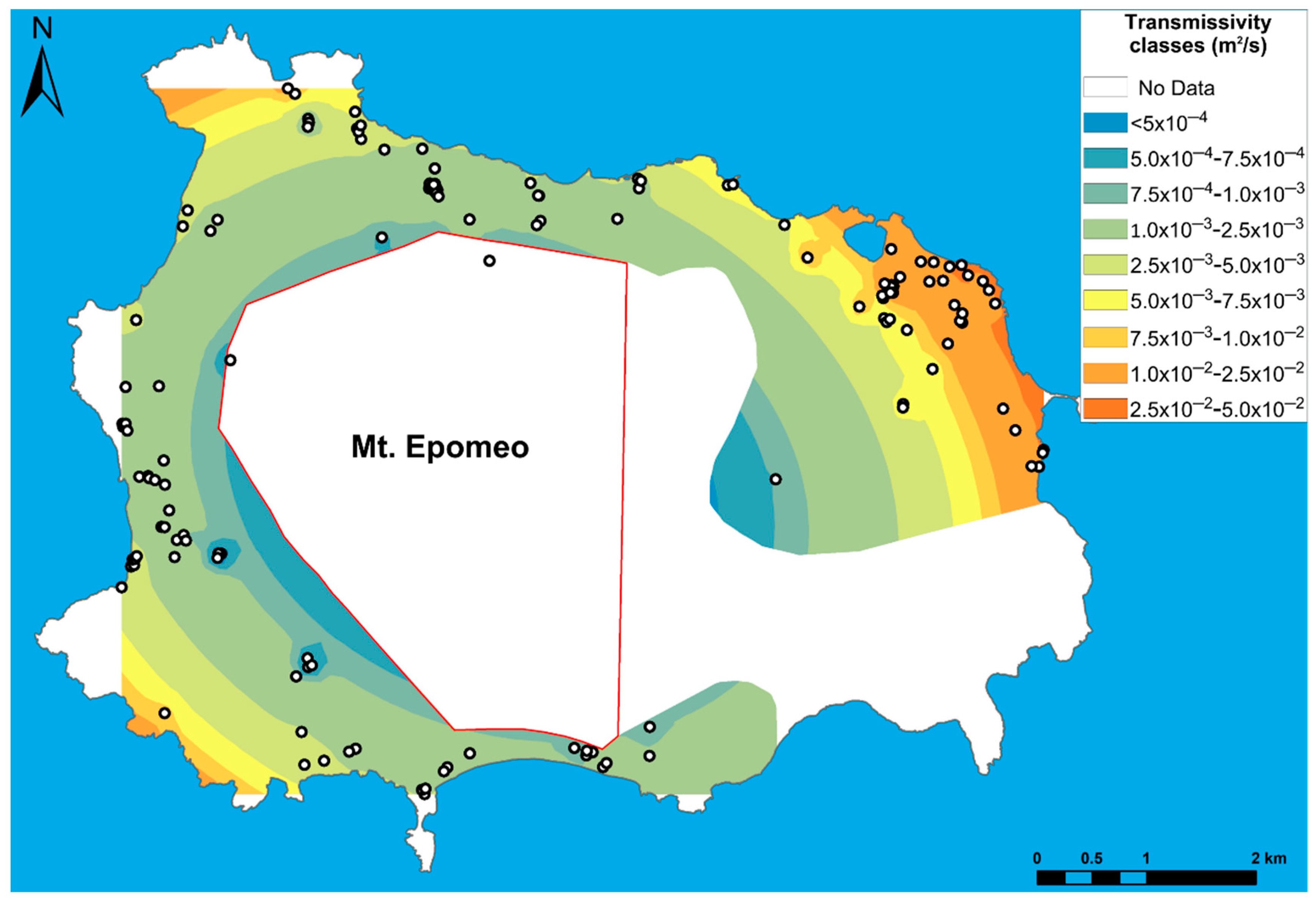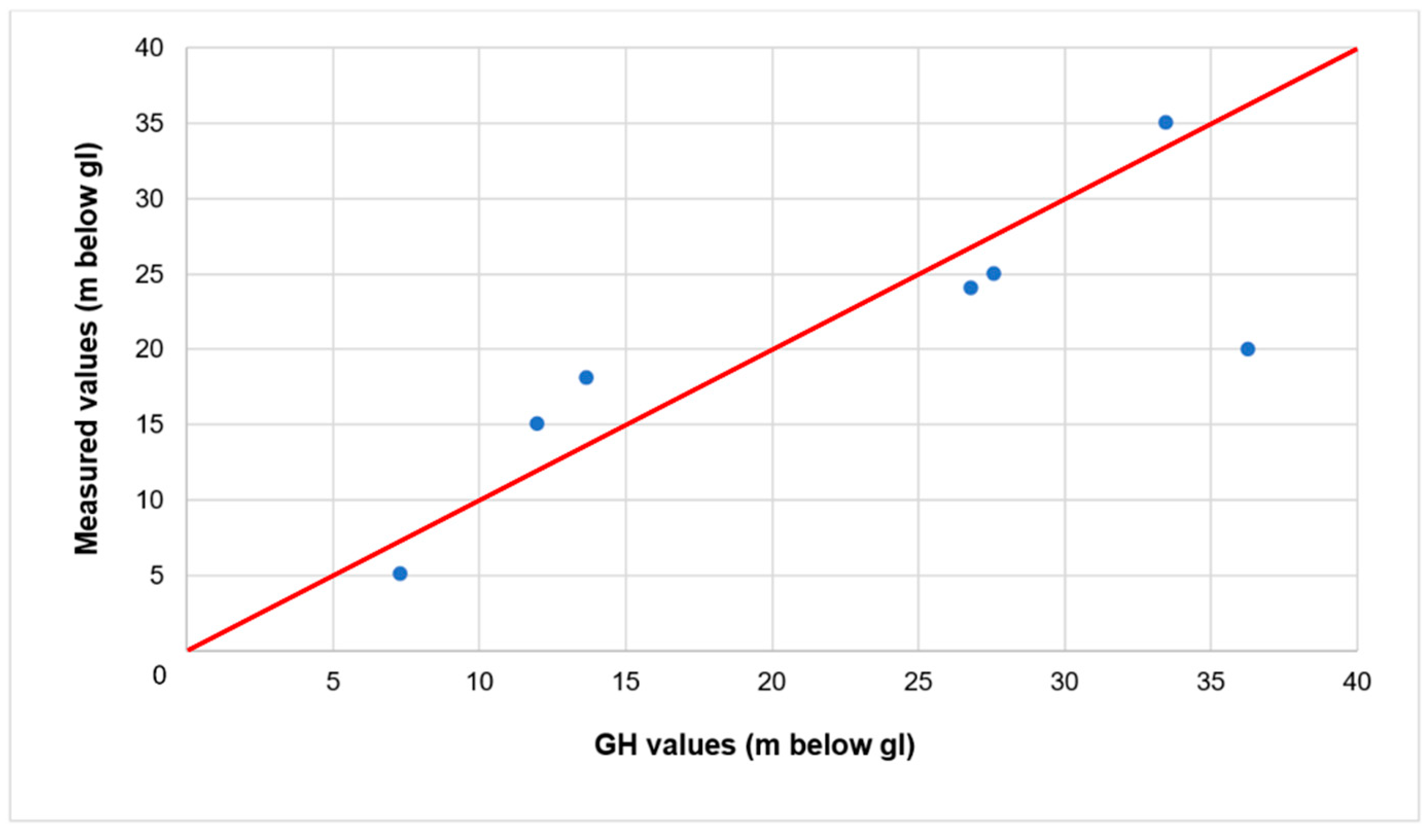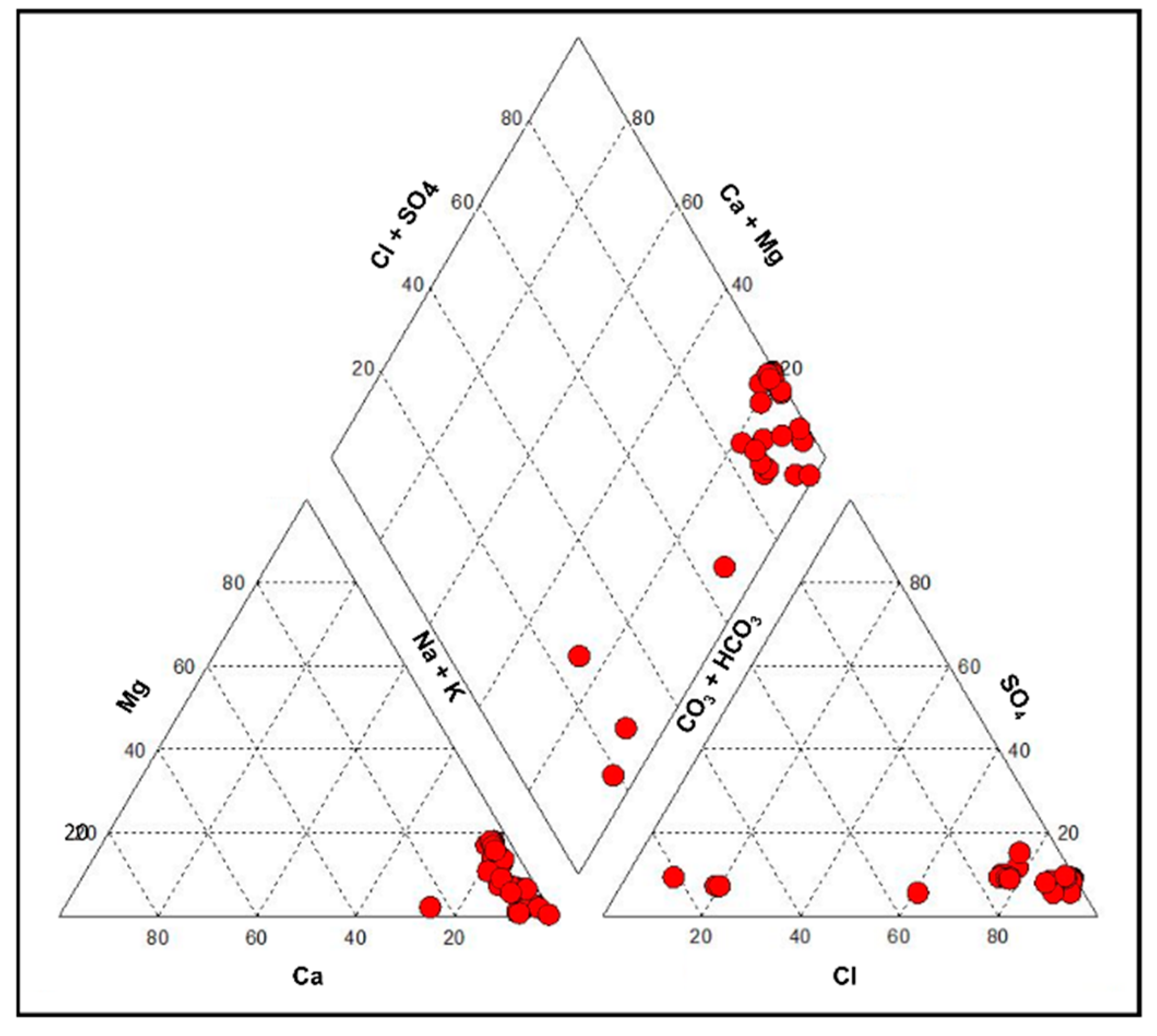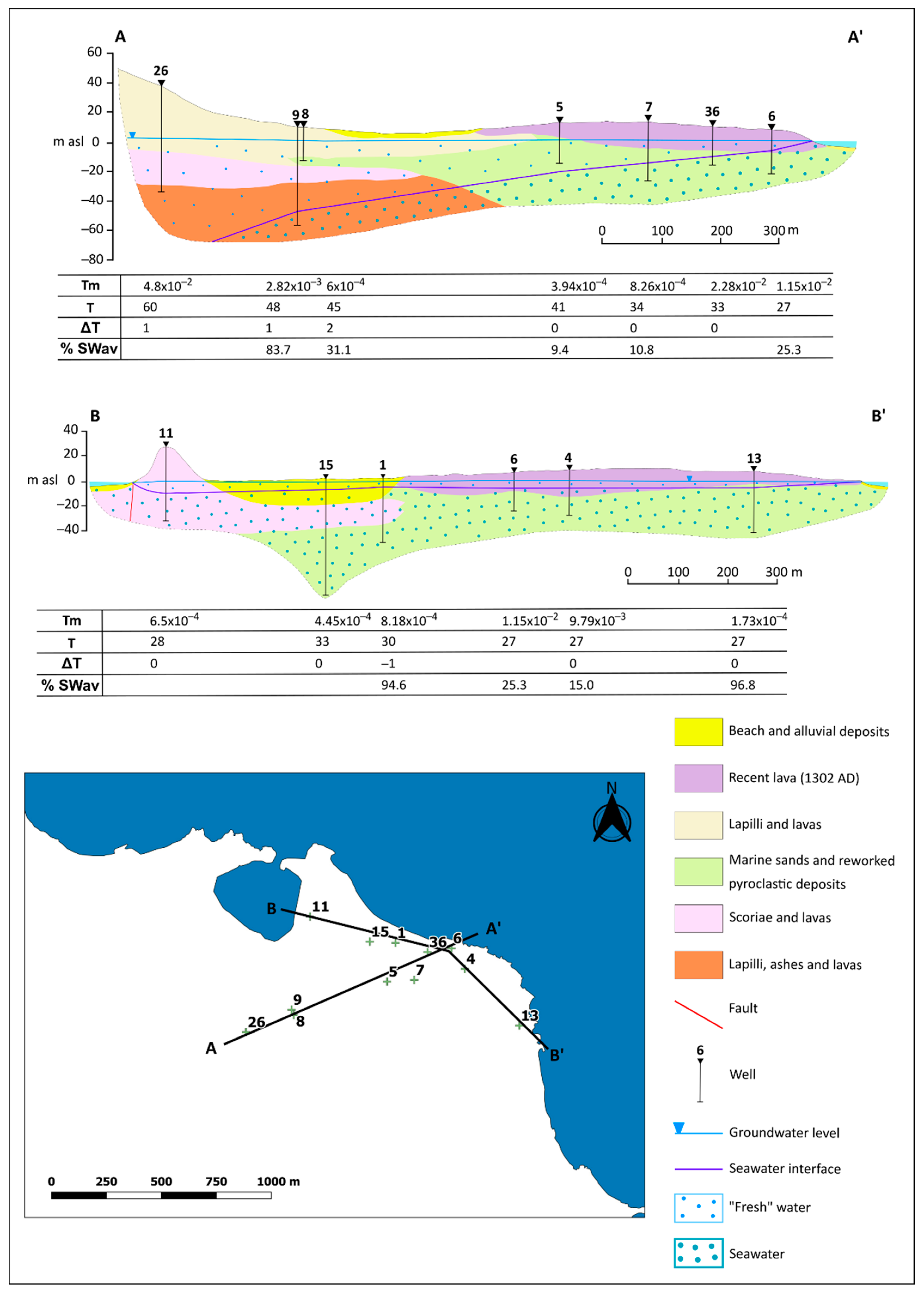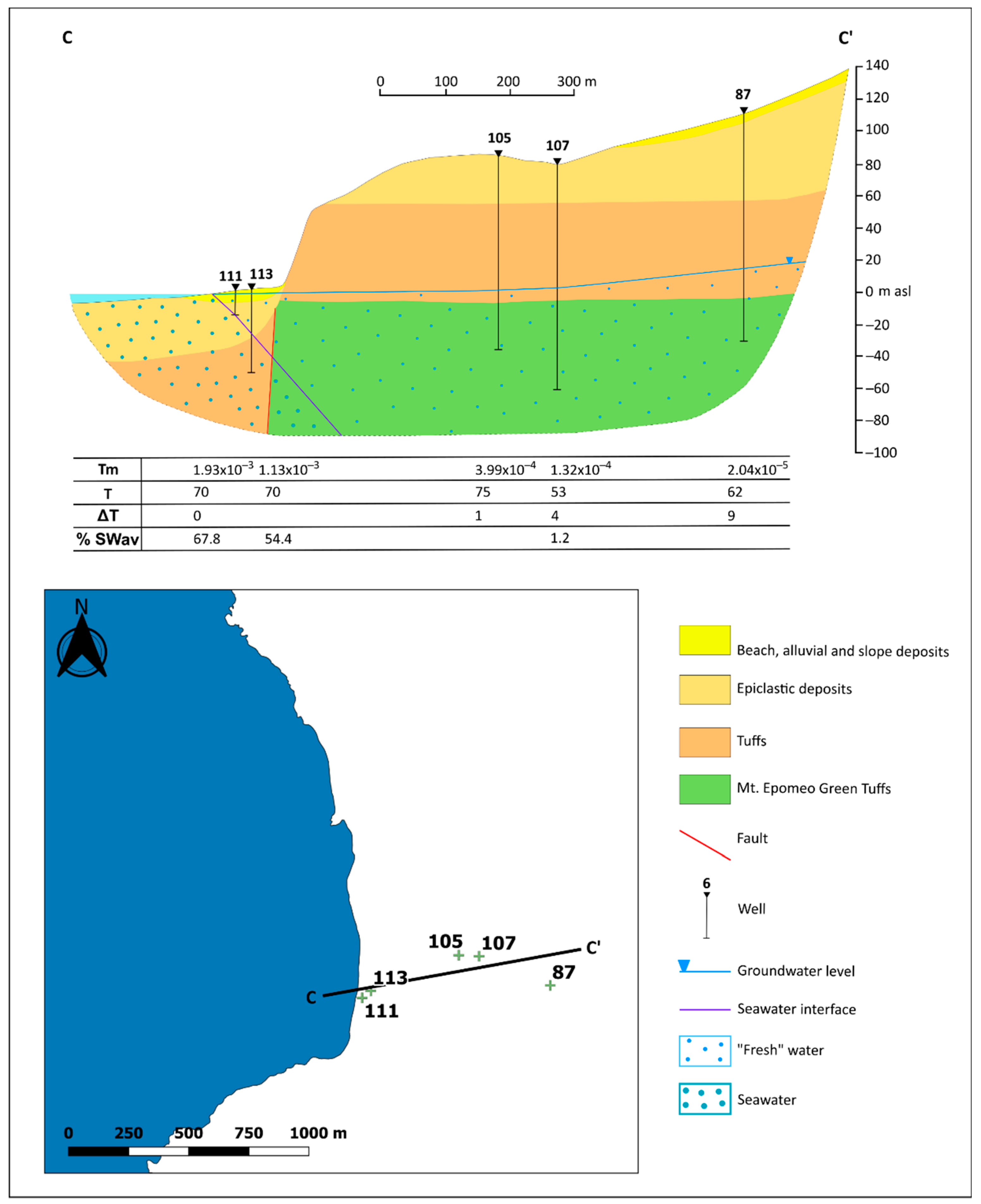1. Introduction
The Island of Ischia, an active volcano located in the Gulf of Naples (southern Italy,
Figure 1), has a long tradition in the use of its groundwaters as a resource for health, wellness, and recreational tourism. The thermal waters of the island have been known since the Romans and in the 16th century, the doctor and philosopher Giulio Iasolino highlighted their therapeutic properties in his essay (i.e.,
De rimedi naturali che sono nell’isola di Pithecusa). Currently, the island is the destination of a significant tourist flow related to thermal waters having about 290 hotels, most of which have health and wellness centers, available on a surface area of 46 km
2. Such activities sustain directly or indirectly the economy of the island [
1].
The remarkable spread of health and wellness centers on the island is linked to the presence of a wide variety of chemical groundwater composition (from calcium-bicarbonate to alkali-chloride waters), temperature (from 13 to 90 °C), and salinity (from 1 to 42 g/L). The groundwater withdrawals for the supply of the thermal and recreational centers are mainly distributed in the coastal strip of the island (
Figure S1) and occur through 244 wells and from 20 springs [
2].
Many studies are available in the literature on the chemistry of the island’s groundwaters, e.g., [
3,
4,
5,
6], but few studies have highlighted the possible impact of withdrawals on the quantity and quality of the groundwater resources [
2]. This last point has economic relevance, given that both the European and Italian legislations establish that the composition and temperature of mineral and thermal waters must remain constant over time (Italian Legislative Decree 176/2011 implementing UE Directive 2009/54/CE). A change in the chemistry of the waters used for spa treatments, for example, requires a new assessment about the therapeutic properties of waters by the Ministry of Health, a procedure that lasts at least one year, with an obvious impact on the activity of the spa.
This study explores the impact of groundwater withdrawals on the quality of the waters used in the thermal centers. For this purpose, the aquifer response to the pumping has been related to the main chemical characteristics of the water extracted, two features that so far were examined separately. This analysis can help to identify the criteria for sustainable management of groundwater resources in the specific case and hydrothermal areas in general.
2. Previous Hydrogeochemical and Hydrogeological Knowledge
The Island of Ischia belongs to the Neapolitan volcanic area (
Figure 1) characterized by a crustal thinning and intense heat flow (up to 500 mW/m
2). Volcanism of Ischia was active from 150 ka to AD 1302 (
Figure 2), giving rise to lava flows, lava domes, and pyroclastic deposits, ranging in composition mainly from trachyte to phonolite, epiclastic deposits, marine sediments, and landslide deposits [
7,
8,
9,
10,
11,
12]. The most remarkable eruption was the Mt. Epomeo Green Tuff eruption (55 ka) accompanied by the caldera collapse, followed by a resurgence phenomenon producing over time an uplift of the Mt. Epomeo block of about 900 m [
13] (
Figure 1). The most complete studies on geology and volcanology of Ischia distinguish from 88 [
7] to 130 stratigraphic units [
11]. The structural setting of the island is related to interactions between the resurgence of the Mt. Epomeo block and regional tectonics (
Figure 1). ENE–WSW to E–W and NNW –SSE to N–S striking systems surround the Mt. Epomeo resurgent block. NE–SW and NW–SE striking systems control the eastern, northwestern, and southwestern structures of the island [
13,
14,
15].
The volcanic area is characterized by an active geothermal system linked to the presence of a shallow magmatic body located at a depth of about 2 km [
7,
13,
16,
17,
18,
19]. Surface manifestations of the geothermal system are hot waters, fumaroles, and steaming grounds. Geochemical studies conducted on the waters and fumaroles of the island have highlighted the presence of a complex hydrothermal system due to overlapping and interconnected reservoirs fed by meteoric waters, seawater, and magma-derived or mixed magmatic-crustal gases [
3,
4,
5,
20,
21,
22,
23,
24]. As to groundwater tapped by wells and emerging from springs, more recent and complete geochemical investigations confirm a wide range of water chemistry, having detected temperatures between 13 and 90 °C, salinities between 0.76 and 42 g/L, composition varying from calcium bicarbonate to alkali-chloride, and concentrations of the dissolved CO
2 between 1 and 448 cm
3/L [
6]. The same authors explain this variability in the physicochemical parameters as the result of complex mixing phenomena among meteoric water, seawater, and three thermal end-members due to hydrothermal deep reservoirs with estimated equilibrium temperature from 150 to 270 °C. The ascending of deep geothermal fluids and mixing with meteoric and seawater determine groundwater quality that supplies the spas of the island.
The most comprehensive studies on the island’s hydrogeology have been conducted by Celico et al. [
25] and Piscopo et al. [
2].
Celico et al. [
25] distinguish two hydrogeological sectors, coinciding with the main volcano-tectonic structures of the island: “Ischia graben”, in the north-eastern sector, characterized by a single aquifer recharged by both rainfall and seawater intrusion, and “Mt. Epomeo horst” and its margins, where a less transmissive and more heterogeneous aquifer has been found. In this last sector, the aquifer is recharged by rainfall, seawater intrusion, and rising geothermal fluids.
Piscopo et al. [
2] recognize an independent and uplifted basal groundwater circulation in the resurgent block of Mt. Epomeo (
Figure 1), where its marginal faults constitute partial barriers to the basal groundwater flow and preferential ways of ascending deep fluids. Groundwater flow in the peripheral area of Mt. Epomeo is mainly influenced by the nature of the aquifer formations. In the northern, western, and southern areas, a continuous basal aquifer and local discontinuous perched aquifers can be distinguished according to the succession of tuffs, ignimbrites, and epiclastic deposits. In the north-eastern area, characterized by the most recent volcanic deposits of the island, a single and continuous basal aquifer with the highest permeability on the island is found (
Figure 1).
In natural conditions, the hydrogeological system is recharged by rainfall (250–290 L/s) and by deep fluids (at least 90 L/s); the discharge is towards the sea and the springs (a total of about 20 L/s). In the peripheral areas of Mt. Epomeo, where there are numerous groundwater withdrawal centers for supplying tourist facilities (
Figure S1), during the peak season, a significant additional recharge of the aquifers derives from seawater and upwelling increase of deep fluids. It was estimated that a total flow between 540 and 620 L/s is simultaneously pumped during the period of operation of the spa facilities (about 180 days per year). This flow is significantly higher than the estimated average meteoric recharge value (250–290 L/s). Specifically, the wells along the coast are also recharged from seawater and the innermost wells are also recharged from deep fluids. Although this does not compromise the availability of groundwater in quantitative terms, the pumping can affect the quality of the water captured by the wells [
2].
3. Materials and Methods
To examine the impact of withdrawals on the quality of water, different investigations were conducted on the wells of the thermal facilities. Investigations included: pumping tests, water temperature measurements during pumping tests, temperature and/or electrical conductivity logs in static conditions, chemical analysis of the water in some wells.
3.1. Pumping Tests
The pumping tests were aimed at examining the aquifer response to groundwater withdrawals in the peak period of the tourist season.
From 1997 to 2018, 155 tests were carried out on 144 wells used to supply the thermal facilities of the island (some wells were tested several times). The main characteristics of the wells are shown in
Table 1. Only two wells (56 and 98) are located in the resurgent block of Mt. Epomeo (
Figure 3). All the characteristics of the wells are not always known.
146 tests were carried out as single-well tests, in 9 tests also an observation well located next (<15 m) to the pumping well was included. 83 tests were carried out at a constant flow rate, 72 step-drawdown tests were carried out by increasing the flow rate in two or three steps, or by interrupting the pumping at each step and waiting for the water level recovery before increasing the pumping flow rate. For 140 tests, the residual drawdown during recovery was measured. The tests were carried out at flow rates between 0.2 and 7 L/s, the pumping duration was between 60 and 330 min for constant flow tests or each step of step-drawdown tests.
The interpretation of the tests was conducted with different approaches according to the different response of the aquifer to pumping.
When a condition of steady-state drawdown was achieved during the pumping time, the specific capacity (SC) was determined using the drawdown measured for the lowest flow rate step in the case of step-drawdown tests. Recovery data were analyzed by the Theis recovery method [
26] and Cooper and Jacob straight-line fitting [
27] to estimate transmissivity. For variable-discharge tests, the recovery phase was analyzed by the Birsoy–Summers recovery method [
28]. In case of significant change in slope in the semilog-plot of recovery data, only the late-time residual drawdown was considered to eliminate well storage effects.
When a condition of unsteady-state flow resulted from the single-well tests, transmissivity values were estimated to apply the Cooper and Jacob straight-line method to drawdown and recovery data. In this case, the early-time section of drawdown in the semilog-plot was ignored. These tests were all conducted at a constant flow rate.
Of the nine tests carried out at a constant flow rate by measuring the drawdown also in an observation well, six showed an unsteady-state trend of drawdown and three a steady-state condition. For the first tests, the transmissivity values were determined by means of drawdown and recovery data measured in the pumping well and in the observation well by the Cooper and Jacob straight-line method. Storativity was also estimated through drawdown data measured in the observation well. For the three tests with a steady-state response, Thiem’s method [
29] was applied to drawdown data, and Cooper and Jacob straight-line method to recovery data to estimate the transmissivity.
The characterization of intersected aquifer formation of the tested wells was obtained from the stratigraphy, saturated thickness, and screen depth of the wells, when available. When direct stratigraphic information of the wells was not available, stratigraphic correlations with the surface geology reported in the 1:10,000 scale geological map of Sbrana and Toccaceli [
11] and with the stratigraphy of the nearest wells were considered.
Statistical analysis of the data examined: the relationships between specific capacity and transmissivity, the relationships between these parameters and the type of aquifer formation, the relationship between transmissivity and thickness of saturated aquifer intercepted by wells, and the spatial distribution of transmissivity. Different kriging models were also used.
3.2. Physicochemical Measurements of Well Water
During the pumping tests, temperature measurements of the water discharged from the production tubing of wells were performed. The measurements concerned 124 tests, determining the temperature (accuracy ± 0.5 °C) after the first 10–20 min of pumping and then once or more until the end of the test. These investigations were aimed at examining the contribution of seawater and the rising of the deep fluids recharging the wells during pumping.
31 temperature (accuracy ± 0.1 °C) and electrical conductivity (accuracy 5%) logs carried out on 24 of the wells tested (
Figure 3) were considered. 19 logs were acquired from a previous study [
2] and 12 logs were performed during this study, in some cases repeating the measurements on previously investigated wells. All measurements were carried out under undisturbed conditions (i.e., in periods without pumping) in accessible wells with known screen depths.
These investigations were aimed at identifying the depth of the seawater interface in coastal areas and comparing it with that obtained from the well-known Ghyben–Herzberg formula [
30].
3.3. Chemical Analyses of Well Water
21 wells (
Figure 3), selected on the basis of previous hydrogeological and hydrogeochemical data, were periodically sampled and analyzed over the period 2006–2019.
Although the number of sampled waters does not fully represent the types of groundwater of the island, the waters of the selected wells represent a large part of groundwaters captured by the wells serving the thermal facilities. The present investigations were not focused on geochemical characterization of the water, widely studied in the past, but addressed the variations over time in the physicochemical properties and composition of the water captured by the wells.
Water temperature, electrical conductivity and pH values were determined in the field by a multiparametric probe (Multimeter 3420, TetraCon 325, SenTix pH electrodes, WTW). Water samples were immediately divide in two parts and stored at 4 °C until the laboratory analyses. The first part was acidified to pH < 2 with HNO3 (1% v/v) and saved for the determination of metals and metalloids, while the second one was kept for major ions determination. Major anions (HCO3−, Cl−, SO42−), nitrate (NO3−) and bromide (Br−) were determined in the laboratory within 24 h from sample collection. HCO3− was determined by means of titration, using HCl 0.1N as a titrant and methyl-orange as a pH indicator.
Metals and metalloids were determined by inductively coupled plasma mass spectrometry (ICP-MS, Aurora M90, Bruker Scientific LLC, Billerica, MA USA). Major ions as NO
3−, SO
42−, Cl
−, F
−, Ca
2+, Mg
2+, Na
+, and K
+ were determined by ion chromatography (IC Metrohm 850 Professional). Cations were separated by a Metrosep C4 250/4.0 column using 3.0 mM HNO
3 as eluent and a flow rate of 0.9 mL × min
−1, whereas anions by a Metrosep A supp7 250/40 column using 3.6 mM Na
2CO
3 as eluent at a flow rate of 0.7 mL × min
−1, and determined through a conductivity detector. Silica was determined by colorimetric method using a Cary UV 50 spectrophotometer (Varian, Palo Alto, CA USA). The ionic balance was checked for all the samples and returned an ionic balance error [
31] less than ±5% in all cases.
5. Discussion
The study allowed us to deepen the knowledge on the hydrogeology of the island, and specifically on the response of aquifer to pumping and its implications on the quality of the water extracted.
Although the island constitutes an active hydrothermal system, the classical interpretation methods of the pumping tests seem to be generally applicable in the case under examination: exceptions to the drawdown-time trends were detected only in wells with the highest water temperatures. It is clear, however, that the estimated transmissivity values should be corrected for the variable conditions of density (ρ) and dynamic viscosity of the fluid (μ). Considering the range of variation of salinity and temperature of the waters of the island, it turns out that the ρ/μ ratio varies between 1 and 2 if compared to standard conditions (pure water at 15.5 °C, ρ = 1.0 g/cm3, and μ = 1.124 cP). A comparison of the estimated transmissivities in the different areas of the island should take into account this correction. However, the wide range in which the estimated parameter falls (from 10−6 to 10−2 m2/s) allow us to attribute its extreme variability mostly to the heterogeneity of the aquifer, making any effect of density and dynamic viscosity negligible in comparison.
As it was found in other volcanic aquifers [
40], higher values of transmissivity are recognized in the most recent volcanic and volcanoclastic deposits and lower values in the oldest pyroclastic and epiclastic deposits of the island (
Figure 5,
Figure 6 and
Figure 7). Sometimes there is an extreme variability of the parameter even among wells very close to each other with little spatial correlation at the small scale. This is due to the complex volcanological history of the island, where, based on the most recent studies [
11], 130 stratigraphic units have been recognized in 46 km
2. These geological-volcanological features result in a significant vertical and horizontal hydraulic heterogeneity which is reflected by: (i) the absence of a direct relationship between transmissivity and thickness of saturated aquifer intercepted by the tested wells for the whole island, (ii) and by the fact that the lowest values of the parameter (4 × 10
−6 to 2 × 10
−5 m
2/s) were found for the very deep wells crossing a more homogeneous ignimbrite sequence of the resurgent block of Mt. Epomeo.
From the different types of tests conducted on wells, it is confirmed that the specific capacity can be a useful parameter for a first estimate of the transmissivity. In the case under consideration, the transmissivity obtainable from Equation (1) is about half an order of magnitude lower than the specific capacity. Similar relationships found in other volcanic areas highlight a smaller difference between the two parameters [
41,
42,
43], but they concern very different aquifers (mainly basaltic lavas) hosting fresh waters.
The hydrogeochemical investigations confirm an extreme variety of the physicochemical characteristics of the island’s groundwaters (TDS from 1 to 41 g/L and T from 25 to 90 °C), as already well known in literature [
3,
4,
5,
6]. The range in salinity and temperature locally influences the water density and the ratio α of Equation (3) used in the Ghyben-Herzberg relationship; applying a locally modified α value, the calculated depth of the seawater interface generally differs little from the one measured.
15 of the 21 wells sampled several times in the period 2006–2019 show significant variations in the quality of their waters (
Figure 12); some of these wells (wells 89, 107, and 153) also show a significant increase in water temperature during pumping (from 4 to 9 °C). The other 6 wells monitored in the same period did not show significant changes in their chemistry and temperature, highlighting the stability of temperature even during pumping. Therefore, comparing what was found for the 21 wells, the differences in the quality of the water extracted over time can be attributed to the effects of pumping in a heterogeneous aquifer, characterized by different recharge boundary conditions.
In general, the wells closest to the coast rapidly reach steady-state conditions during pumping, show higher transmissivity values, a greater percentage of seawater in the captured waters, and stability of water temperature during pumping (indeed in some cases a decrease has been measured,
Figure 8). In many cases, the boreholes are deeper than the “fresh” water-seawater interface already in static conditions (i.e., before pumping). Examples of this are shown in the hydrogeological sections of
Figure 13, which cross the north-eastern coastal sector.
In the first cross-section (A-A’ in
Figure 13), an increase in the water temperature as the depth of the seawater interface increases can be observed, while there is no change in temperature during pumping for the wells where the seawater interface is less deep. The transmissivity varies between two orders of magnitude, with the highest values for wells intercepting significant lava thicknesses (wells 26, 9, 7, 36, and 6). It is noteworthy that the wells closest to the coast (wells 7 and 6), which already in static conditions pierce the interface, show a percentage of seawater under pumping lower than the inner wells (wells 8 and 9). This can be explained by taking into account that the wells closest to the coast intercept a significant thickness of the most recent blocky lavas of the island (Arso lavas, dated 1302 AD). The thickness of the most superficial and more permeable lava layer can determine the percentage of seawater captured by the well, which tends to be fed by the landward inflow, limiting the seawater upconing. From cross-section B-B’ as well (
Figure 13), the thickness of recent blocky lavas intercepted by the wells seems to locally influence the transmissivity and the percentage of seawater captured during pumping.
Moreover, the response of the aquifer to pumping also depends on the possible interference between neighboring wells and on the change in the groundwater level induced by tides, taking into account that in this area there is one of the highest densities of wells operating simultaneously during the peak season (
Figure S1) and the piezometric level is only a few decimeters above sea level (asl) in static conditions (
Figure 1). Together, these conditions have an impact on local and variable seawater upconing with a consequence on the quality of the water captured by the wells.
For the innermost wells of the island, the parameter that shows a higher variability during the sampling period 2006–2019 is the water temperature (wells 89, 107, and 133 in
Figure 12). These wells are located in one of the areas of the island (
Figure 3) characterized by a more active hydrothermal circulation which is reflected in the highest groundwater temperatures and a widespread presence of fumarole fields [
3,
4,
5,
6]. In this area, but also in the other north-western, western, and southern sectors of the island characterized by the similar hydrothermal conditions, the highest increases in water temperature during pumping have been found (
Figure 8 and
Figure 9), and in some cases even the rise in the piezometric level in the last stages of pumping (
Figure 8). In these areas the transmissivity values are low (
Figure 6 and
Figure 7) and often an unsteady response of drawdown was found during pumping. These conditions can explain the temperature variations of the water captured by the wells, which are related to an increase of upwelling of deep hydrothermal fluids during pumping. In this case, neighboring wells show differences in the variations of water temperature during pumping, which depend on the local transmissivity of the aquifer, the depth of the well, and, generally, on the complex volcano-tectonic setting of these areas (
Figure 1). An example of the different hydrogeological conditions moving from the coast to the innermost areas of the island, as well as of related impacts on the quality of the groundwater captured by the wells, is shown in the cross-section of
Figure 14.
Wells that showed insignificant changes in water quality during the monitoring period (wells 2, 3, 8, 108, 113, and 150 in
Table S4) are characterized by a low operating flow (lower than 4 L/s), a piezometric level in static conditions higher than 0.8 m asl and a transmissivity generally higher than 5 × 10
−4 m
2/s.
General criteria for the sustainable management of the island’s thermal waters can be drafted from the results of the study.
In coastal areas, to maintain the quality of the thermal waters over time, the flow rate to be granted to each thermal centers should take into account the local transmissivity of the aquifer, defining the depth of the wells in relation to the local stratigraphy, distance from the coast and between neighboring wells. In the innermost areas of the island, the flow rate and duration of the pumping from each well should be defined by not exceeding a threshold of drawdown, especially in areas with low transmissivity. This is necessary to prevent the increase of the ascent of the deep fluids, which can determine changes in the quality of water extracted from wells.
The implementation of the proposed approach can be achieved through a participated management advised by decision-support modeling [
44,
45,
46]. This modeling should be focused on the search of an equilibrium point between profit maximization of thermal waters and their conservation. The knowledge of the relationship between response to pumping and quality of the extracted water from wells presented in this study represents key points to be considered in the overall decision-making process. The sustainable management of hydrothermal resources needs to rely on the local results of pumping tests with monitoring of drawdown, temperature, and salinity of the extracted water. The concomitant analysis of these three indicators is effective to define the sustainable yield of the single well.
6. Conclusions
This study examined the response to pumping of the volcanic aquifer of the Island of Ischia, an active hydrothermal system where numerous spas extract thermal waters that are significantly different in temperature, salinity, and chemical compositions.
The stratigraphic and volcano-tectonic complexity of the island determines a remarkable hydraulic heterogeneity. Consequently, the quality of groundwater extracted from the wells depends not only on natural phenomena (meteoric recharge, seawater intrusion, and rising of deep hydrothermal fluids) but also on the island sector where groundwater is pumped from and on the pumping method. The distance of the wells from the coast, the type of aquifer formation intersected by the wells, and the field of groundwater temperature of the hydrothermal system are the factors that most affect the aquifer pumping response, determining the quality of water extracted from wells and its variation over time.
In the case study, more than in other hydrothermal systems, techniques, and regimes of groundwater withdrawals should dynamically adapt to the local response of the aquifer to pumping. The concomitant analysis of drawdown, water temperature, and salinity during pumping, associated with decision-support modeling, turns out to be a valuable tool to define the sustainable yield of the single well.


